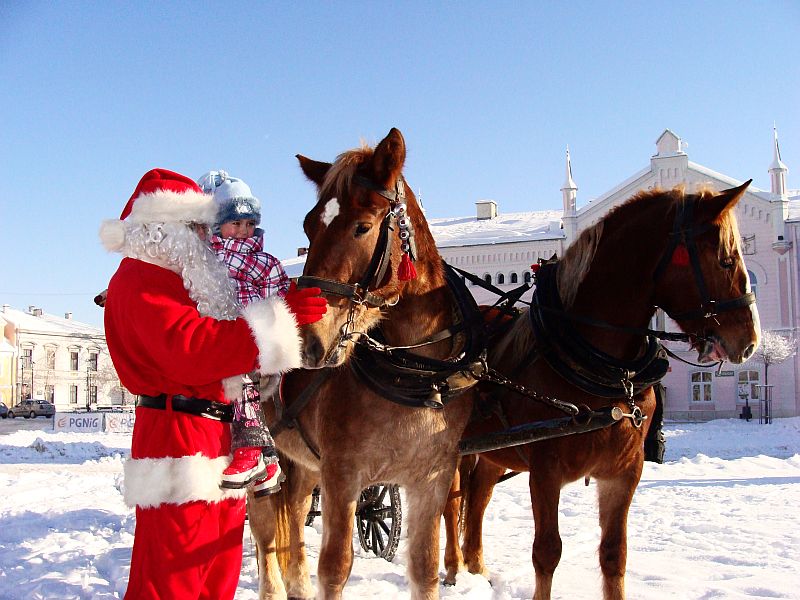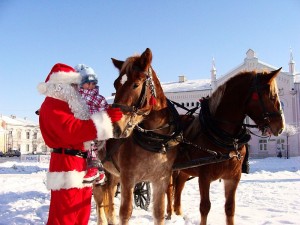Would there be a Christmas without animals? It seems like a silly question but think about it; so many of our holiday traditions involve animals in some way. There are the obvious participants; the poultry, pigs, lambs and, in some countries, fish which will be the highlights of millions of Christmas dinners. Indeed, the Christmas story as we know it could not have happened without animals; Mary and Joseph were unlikely to have reached Bethlehem in time without the aid of their “little donkey on the dusty road”. Tucked away in their manger, it would have been vacant and lonely without the “cattle lowing” (although Pope Benedict’s suggestion from last year created some doubt around the traditional cast of manger characters). Without animals, the shepherds would have missed their angelic visitor and we would have to change their song too (although fortunately “watched their flocks” can be easily tweaked to “washed their socks”…). Finally, without their camels the three wise men would have been highly unlikely to reach Bethlehem by the 6th of January. They would have either been significantly delayed, in which case sad Christmas trees long past their glory days would now droop in houses around the world until the spring, or they may not have completed their journey at all and we would lose the annual joy of generations of school children attempting to pronounce the words frankincense and myrrh with gusto.
Difficult as it may be, it is still theoretically possible to imagine a vegetarian Christmas or an animal-free version of the nativity. However, there is one integral part of Christmas which could absolutely not happen in any possible way without the participation of the most important holiday animals of all; reindeer.
Santa didn’t always travel by reindeer. St. Nicholas, the 3rd century Turkish bishop who (along with some help from Coca Cola) is the foundation of our modern views of Santa Claus, certainly didn’t have any reindeer. In Holland, St. Nicholas still brings presents on the 5th of December and, instead of reindeer, prefers to travel by means of a white horse with the help of “six to eight black men”.
Reindeer first came on the scene in two children’s books from the early 19th century, the most famous of which was Clement C. Moore’s The Night Before Christmas. Published in 1823, Moore was the first person to reveal the reindeers’ names; a very important service; imagine the embarrassment if we had to address our reindeer food presents to “whom it may concern” instead of to Dasher, Dancer, Prancer, Vixen, Comet, Cupid, Donner or Blixen directly.
Rudolph first joined the group in 1939. In the increasingly urbanised and atmospherically polluted 20th century, Rudolph’s luminous nose was definitely an asset for Santa’s night time navigation (and of course the constant red light helped him to comply with new low-flying aircraft identification regulations). Rudolph’s importance was exemplified by his own theme song written in 1949. Rudolph’s red nose is often assumed to be a natural bioluminescence, making him unique among terrestrial vertebrates and justifying the provision of carotene-rich carrots as an important dietary supplement to the normal reindeer diet. However, new thermographic images from Lund University have revealed that Rudolph’s glowing nose seems to be a by-product of the constant blood supply which is necessary to prevent the exposed, sensitive skin from freezing.
Similarly, recent research has also confirmed that reindeer’s eyes are seasonally adapted to low light levels so they are certainly well-suited to their night time global navigation duties. Santa clearly picked the right animals for the job.
Incidentally, it’s not clear whether we should be referring to Rudolph or Rudolpha. Santa has a well-deserved reputation as one of the first equal opportunities employer and the fact that he hasn’t felt the need to clarify the reindeers’ genders (or to preferentially hire naturally winged steeds for the task at hand) just confirms his exemplary egalitarian approach to employment practice.
So whether you’re feigning gratitude for some welcome gift, enjoying the sanctimonious pleasure of an extended family gathering or just settling down to watch the Strictly Come Dancing Christmas special (I’m sure it’s not just me…) spare a thought this Christmas for the animals past and present, edible and domesticable, mythical and magical which make our holidays so special.
Author: Sive Finlay, sfinlay[at]tcd.ie, @SiveFinlay
Image source: Wikicommons


